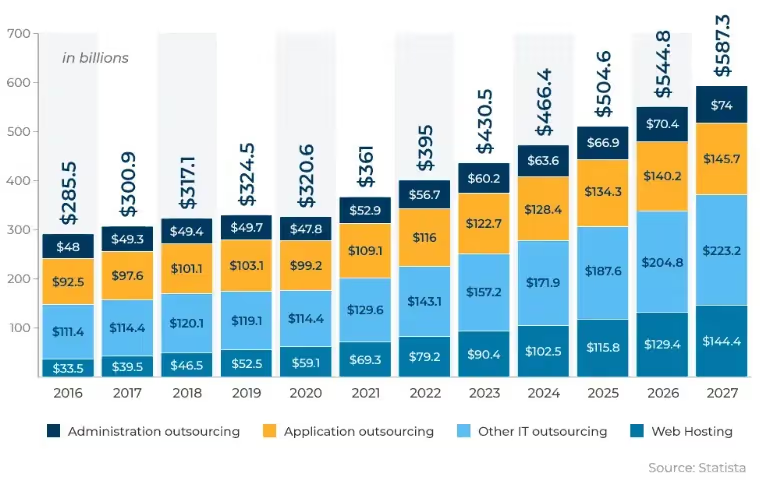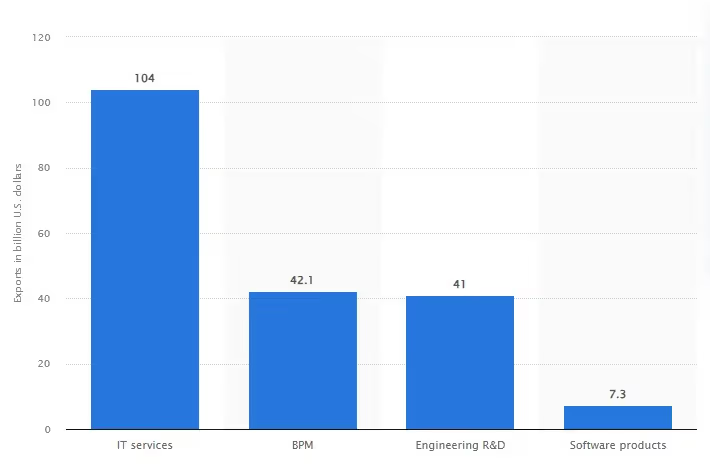The dynamic landscape of software development increasingly relies on outsourcing to meet the demand for skilled labor, especially in areas like DevOps engineering. This global trend has positioned India and Latin America (LATAM) as leading destinations for outsourcing. Each offers unique advantages and challenges in the quest for the most suitable DevOps talent. Also, the global IT outsourcing revenue is continuously growing and the anticipated annual growth rate for the period from 2024 to 2027 is 7.93%.

This article dives into a comparison between these two regions, India and LATAM, focusing on their talent pools, hiring costs, business culture, communication, and development expertise.
General Considerations for DevOps Outsourcing
Outsourcing DevOps functions can be a strategic move for businesses aiming to enhance operational efficiency and agility. The decision to outsource, however, should be informed by several critical considerations:
- Cost Efficiency: Balancing quality with affordability is paramount, as businesses seek to maximize their investment in DevOps capabilities.
- Talent Availability: Access to a skilled and experienced talent pool directly influences the success of DevOps initiatives.
- Time Zone Compatibility: For real-time collaboration, time zone alignment can facilitate smoother communication and project management.
- Language and Cultural Barriers: Proficiency in English and cultural compatibility can significantly impact the outsourcing relationship.
These factors underscore the importance of choosing the right outsourcing destination, as it can affect project outcomes and business objectives. Let's dive into them.
Talent Pool
India undoubtedly possesses a formidable talent pool, fueled by its longstanding focus on STEM education and a vast workforce. However, the tech landscape in LATAM is rapidly evolving, with countries like Brazil, Mexico, Colombia and Argentina witnessing a surge in tech talent. LATAM's emphasis on nurturing a vibrant startup ecosystem and investing in tech education is yielding a new generation of skilled DevOps engineers, rivaling India in both quantity and quality.
Hiring Costs
While India may have traditionally been perceived as the more cost-effective option for outsourcing, the landscape is shifting. LATAM offers competitive pricing combined with a growing emphasis on quality and innovation. This makes it an attractive proposition for companies seeking value beyond just cost savings. With the right balance of affordability and quality, LATAM emerges as a compelling choice for businesses looking to optimize their DevOps initiatives.
Business Culture and Communication
The cultural alignment between LATAM and North American businesses is a significant advantage. LATAM's business culture is characterized by flexibility and informality, fostering a collaborative environment conducive to innovation. Furthermore, LATAM's geographical proximity ensures smoother communication and real-time collaboration, overcoming the challenges posed by time zone differences often encountered when working with Indian partners.
Development Expertise
India's reputation for technical prowess in software development is well-established. However, LATAM is quickly gaining recognition for its proficiency in technological skills and creative problem-solving. LATAM's DevOps engineers bring a fresh perspective to the table, combining technical expertise with innovative approaches to address complex development challenges. This blend of skills and adaptability positions LATAM as a strong contender in the global outsourcing landscape.
India as a DevOps Outsourcing Destination
India has long been recognized as a global leader in IT outsourcing, attributed to its vast pool of technical talent and cost-effective services.

Here’s why India stands out:
- Extensive Talent Pool: With millions of IT professionals, India offers unparalleled access to skilled DevOps engineers.
- Cost-Effectiveness: Indian IT services are known for their competitive pricing, providing businesses with cost savings without compromising on quality.
- English Proficiency: As English is widely spoken within the professional context, communication is generally not a barrier.
Despite these advantages, businesses must consider the time zone differences that can pose challenges for teams requiring real-time collaboration.
LATAM as a DevOps Outsourcing Destination
LATAM has rapidly emerged as a favorable destination for DevOps outsourcing, particularly for North American companies, due to:
- Cultural and Time Zone Alignment: Sharing similar time zones with North America, LATAM enables real-time collaboration, making it an ideal nearshore option.
- Growing Tech Talent: The region has made significant strides in tech education and training, contributing to a growing pool of skilled DevOps engineers.
- Competitive Costs: Outsourcing costs in LATAM are favorable compared to North American rates, with the added benefit of proximity and cultural affinity.
- English Proficiency: As English is widely spoken within the professional context, communication is generally not a barrier.
Let's dive into the top Latin American countries:
Brazil is South America's largest economy and a significant DevOps outsourcing hub, boasting over 500,000 IT professionals and about 23,000 new DevOps graduates each year. It's noted for its advanced technical knowledge and English proficiency, making it a strong competitor in software outsourcing.

Mexico has become a prime destination for IT outsourcing and nearshoring, with companies like Amazon, Facebook, and Google increasing their presence there. Mexico's advantages include cost savings, similar time zones to the US, a growing and specialized talent pool, intellectual property laws, and strong tech infrastructure. It shares PST, MST, CST, and EST time zones with the US, offering a convenient overlap for collaboration.
Argentina, Costa Rica, and Colombia are also notable outsourcing destinations. Argentina is known for staff augmentation and software development. Costa Rica specializes in BPO and software development. Colombia is recognized for its software development capabilities.
These attributes make LATAM an attractive choice for companies prioritizing ease of communication and collaboration.

Direct Comparison: India vs LATAM
When comparing the two, it's clear that both India and LATAM offer distinct advantages. However, for companies in North America, the scales might tip in favor of LATAM due to:
- Real-Time Collaboration: The time zone overlap with North America enables real-time feedback and collaboration, a critical component of DevOps practices.
- Cultural and Language Compatibility: LATAM's cultural similarities and widespread English proficiency minimize barriers to effective communication.
- Innovation, Quality and Cost: While India may offer cost advantages, LATAM's growing emphasis on innovation and quality, particularly in tech development, suggests a better long-term value for companies focused on cutting-edge solutions.
Conclusion
While India continues to be a global powerhouse in IT outsourcing, LATAM's unique advantages make it an increasingly attractive destination for DevOps outsourcing, particularly for North American businesses. The region offers a compelling mix of cultural and time zone alignment, a rapidly growing talent pool, and a focus on innovation, making it an ideal partner for companies looking to thrive in the digital age.
Ready to explore your options? Use our calculator below and contact us to make an informed decision for your business.








